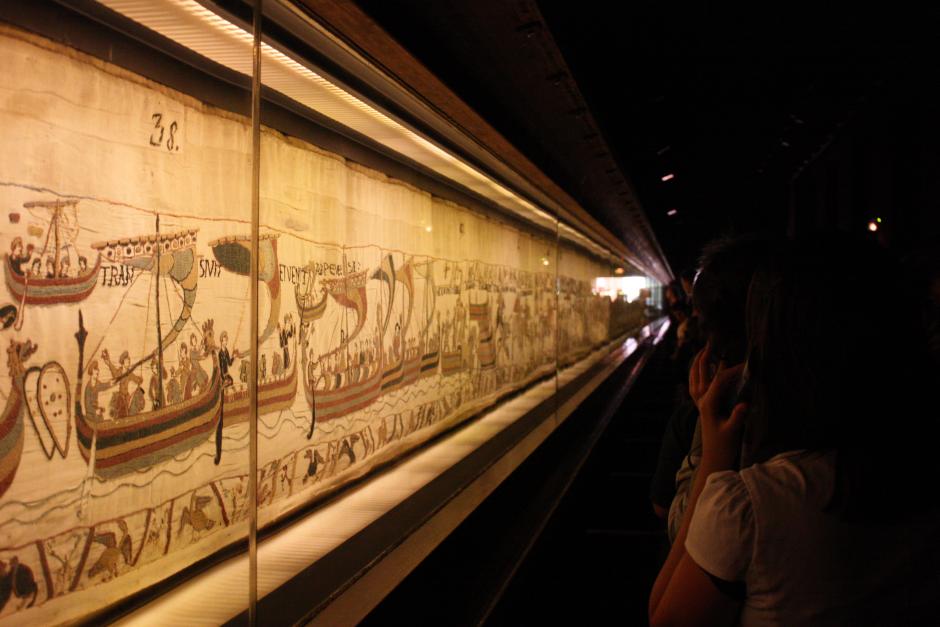
Visualization Studio provides a study abroad experience right here on campus

Library Staff create an immersive visualization experience of the Bayeux Tapestry for NCSU students of medieval history.
The Bayeux Tapestry is one of the greatest known works of the early medieval world. Completed around 1080, this embroidered cloth tells the story of William the Conqueror’s 1066 conquest of England.
To experience the grandeur of the 224-foot long, 20-inch tall tapestry, one would have to visit it at the Bayeux Museum in Normandy, France, where it is on permanent display. Although digital images of the tapestry are available, it is difficult to get a sense of its scale on a normal computer monitor.
 The Bayeux Tapestry at its home in Bayeux, France. (photo credit: boris doesborg)
The Bayeux Tapestry at its home in Bayeux, France. (photo credit: boris doesborg)
Over 930 years after the Bayeux Tapestry was commissioned, library staff at NC State were looking for a project that would demonstrate the capabilities of the visualization spaces at the James B. Hunt Jr. and D. H. Hill Libraries. The tapestry, which is frequently studied in medieval history courses at NC State, seemed an ideal candidate to display at full scale.
In Fall 2014, library staff members Shaun Bennett and Markus Wust approached Dr. Julie Mell, who teaches intro-level and upper-level medieval history classes. Would she be interested, they wondered, in bringing her students to the library for an immersive visualization experience with the Bayeux Tapestry?
With Mell on board, Bennett and Wust worked together to place public domain images of the Bayeux Tapestry on a website which could be accessed from any of the Libraries’ visualization spaces. With the resolution set so the tapestry displayed at its true size, the image wrapped around the Hill Visualization Studio four times and around the Hunt Teaching and Visualization Lab room twice.
First, Dr. Mell brought a class of undergraduate students, in two groups, to D.H. Hill’s Visualization Studio and experimented with different ways of interacting with the tapestry. For the first class, the room was set up for a traditional lecture, with the tapestry displayed on the walls around them. With the second group, Dr. Mell employed a scavenger hunt technique, asking students to find specific items in the tapestry (a hawk on a king’s fist, a plow being drawn by oxen, even dragons sewn into the borders) and explain why those objects were significant.

The second class to visit the virtual tapestry was an upper-level class, and Dr. Mell gave these students more freedom to explore the tapestry and to discuss it in depth. Students walked around the room finding items from the scavenger hunt, reading the text of the tapestry, and exploring the design decisions made by the makers of the tapestry.
Students enjoyed working with the digital tapestry, and when each class entered the room and were surrounded by the imagery, a chorus of “oohs” and “aahs” could be heard. Dr. Mell herself was also pleased with the experience. The large-scale visualization spaces made it possible to take students on a field trip to view artifacts from medieval Europe without leaving campus. And the mix of lecture and student interaction with the tapestry in the next two sessions thoroughly engaged the students.

Mell, Bennett, and Wust have all expressed interest in repeating the Bayeux Tapestry visualization in future semesters. For their part, Bennett and Wust have said they would like to acquire higher-quality digital images of the tapestry to display. Dr. Mell would like to encourage student engagement and “make the experience more like a museum guided tour” by removing the chairs from the room.


